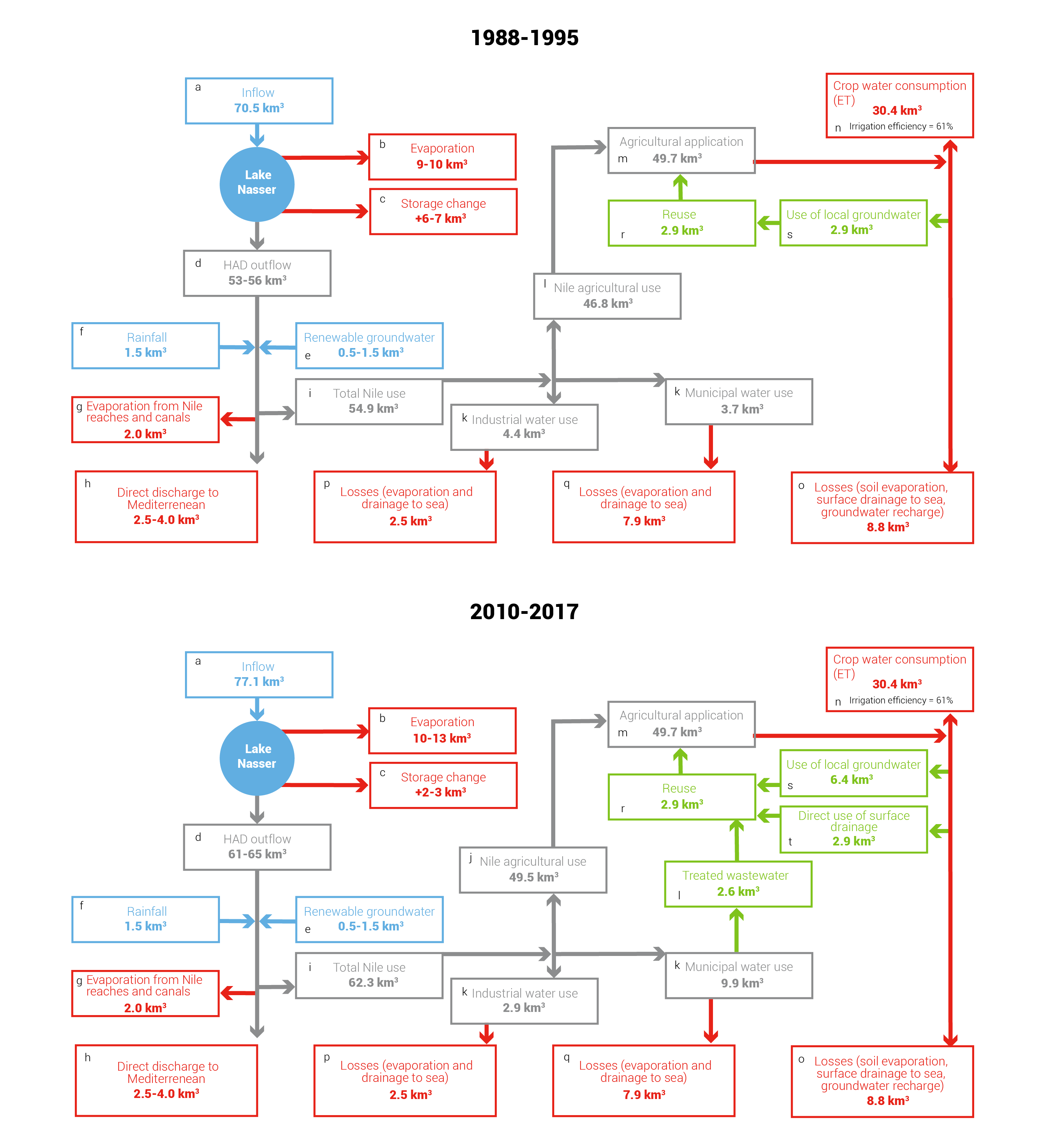
Water uses per sector
Egypt currently experiences a 13.5 BCM/yr water shortage, and this number is predicted to keep rising. Water drainage and reuse is used to compensate for this shortage, which degrades the quality of the water.[3] Importing virtual water is also used to fill the gap. The term ‘virtual water’ refers to the subtle flow of water in food or other commodities that are exchanged from one region to another. Egypt is poised to import more virtual water than Nile water, throwing into doubt the historical description of Egypt as ‘the gift of the Nile’.
The Nile has provided Egypt with more water than it needs for thousands of years. Water demand has expanded in tandem with population growth and economic expansion. According to the Egyptian government, the country has entered the water poverty stage, with less than 500 m3 of water per person per year. From a surplus of approximately 20 km3 per year in the 1960s, Nile water supply had decreased to a deficit of approximately 40 km3 per year by late 2010.[2]
Figure 2. Areas equipped for irrigation in Egypt.
Agriculture is vital to the Egyptian economy, accounting for approximately 14.5% of GDP. The agricultural sector utilizes the most water, accounting for more than 85% of Egypt’s Nile water allocation. Although the country has lost part of its fertile ground to urban growth, efforts are being made to compensate by increasing agricultural areas in the desert. The overall farmed land was estimated to be around 3.89 million hectares, with 2.56 million hectares being old land and 1.33 million hectares being newly reclaimed land. The Nile is the main source of irrigation water. More than 90% (332,000 hectares) of the agricultural land area is irrigated with surface water.[4] The amount of water used in agriculture from this source is predicted to reach 3.6 BCM by 2025.[5]
Drinking water is Egypt’s second most significant water use industry. This sector requires 10 BCM/yr to meet demand, a number that is expected to rise to 13 BCM by 2025. Pipeline water sources are used by approximately 97% of the urban population and 70% of the rural population. Surface water supplies approximately 83% of total safe drinking water needs, while groundwater meets the remaining 17%.
The industrial sector used 5.4 BCM of water annually in 2017, according to the Ministry of Water Resources and Irrigation.[2]
Expected water consumption
Population increase, economic expansion and shifting consumer habits are all contributing to rising water demand. Over the previous 100 years, water demand has surged by 600% worldwide. This translates to a 1.8% annual increase rate. Nikiel and Eltahir [2] assert that the current yearly growth rate is less, at 1%, but this estimate could be optimistic. Over the next two decades, there will be a huge increase in the demand for water across all three sectors: industry, household and agriculture.
Although household and industrial demand will increase more quickly than agricultural demand, agricultural demand will still be the highest. By 2050, the annual global water demand for all purposes, which is currently around 4,600 km3, will rise by 20-30%, hitting 5,500-6,000 km3.[6] Egypt is predicted to require 170 km3 of water per year to meet its needs.[2]
Water management is addressed in the government’s National Water Resources Plan 2037. The plan outlines specific steps to address current and future water sector issues, such as the construction of new irrigation systems, water desalination programmes in coastal areas and water reuse with treated wastewater. The plan is based on four major pillars: improving water quality, developing water resources, creating an enabling environment and rationalizing water use.[7]
[1] Worldometers. Egypt water. [cited 2023; Available from: https://www.worldometers.info/water/egypt-water/#no-access-water.
[2] Nikiel, C.A. and Eltahir, E.A.B., 2021.Past and future trends of Egypt’s water consumption and its sources. Nature Communications, 12(1): 4508.
[3] Omar, M.E.D.M. and Moussa, A.M.A., 2016.Water management in Egypt for facing the future challenges. Journal of Advanced Research, 7(3): 403-412.
[4] Abdulkarim H Seid, Milly Mbuliro, et al. Irrigation in the Nile basin: irrigation areas in Egypt. Nile Basin Water Resources Atlas 2023.
[5] Luo, P., Sun, Y., et al., 2020.Historical assessment and future sustainability challenges of Egyptian water resources management. Journal of Cleaner Production, 263: 121154.
[6] Boretti, A. and Rosa, L., 2019.Reassessing the projections of the world water development report. NPJ Clean Water, 2(1): 1-6.
[7] Novo, C. Egypt to invest $50 billion in drinking water by 2037. 2019; Available from: https://smartwatermagazine.com/news/smart-water-magazine/egypt-invest-50-billion-drinking-water-2037.

